
It’s time to tell you the truth about the PL-300 exam: One of the best ways to prepare for the Microsoft PL-300 exam is to use practice tests. PL-300 practice test can help you assess your knowledge, identify your strengths and weaknesses, and familiarize yourself with the exam format and question types. You can also learn from your mistakes and improve your test-taking skills.
How do I pass the PL-300 exam? You’ll need to choose a reliable and up-to-date source of practice testing to help you pass the Microsoft Power BI Data Analyst exam.
To give you the plan to choose from: Go to Pass4itSure to download the latest PL-300 dumps to get the latest PL-300 practice test 295 new question and answer preparation exam https://www.pass4itsure.com/pl-300.html
Here are the latest practice questions that you can participate in for free
PL-300 free dumps last updated: https://www.work2you.org/pl-300-dumps-updated-successfully-cleared-microsoft-pl-300-prepare-materials/
Question 1:
DRAG DROP
You build a report about warehouse inventory data. The dataset has more than 10 million product records from 200 warehouses worldwide.
You have a table named Products that contains the columns shown in the following table.

Warehouse managers report that it is difficult to use the report because the report uses only the product name in tables and visuals. The product name is contained within the ProductDescription column and is always the fourth value.
You need to modify the report to support the warehouse manager’s requirement to explore inventory levels at different levels of the product hierarchy. The solution must minimize the model size.
Which three actions should you perform in sequence? To answer, move the appropriate actions from the list of actions to the answer area and arrange them in the correct order.
Select and Place:
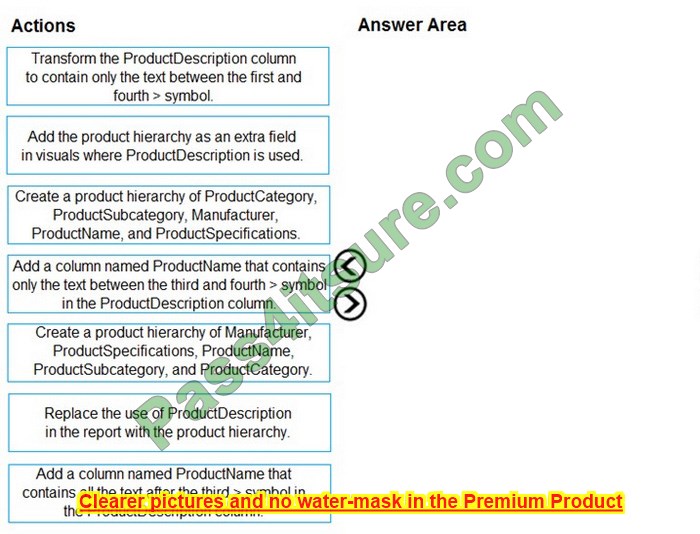
Correct Answer:
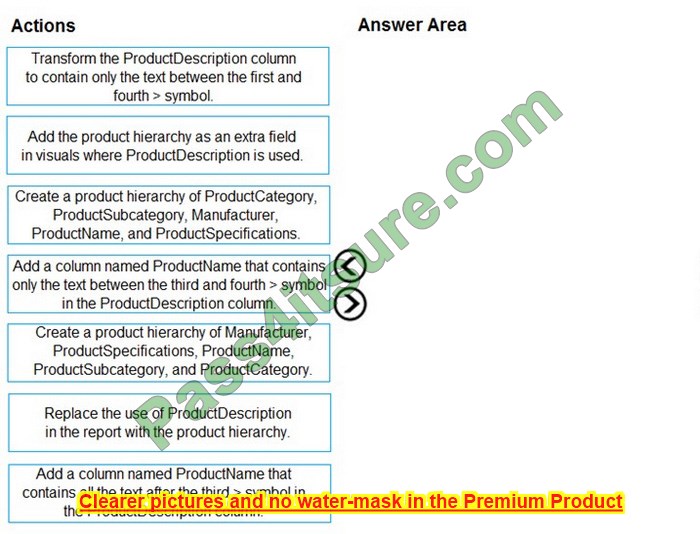
Power BI Desktop supports the use of inline hierarchy labels. With inline hierarchy labels, you can see hierarchy labels as you expand visuals using the Expand All feature.
Reference: https://docs.microsoft.com/en-us/power-bi/create-reports/desktop-inline-hierarchy-labels
Question 2:
You need to create a visual that enables the ad-hoc exploration of data as shown in the following exhibit.
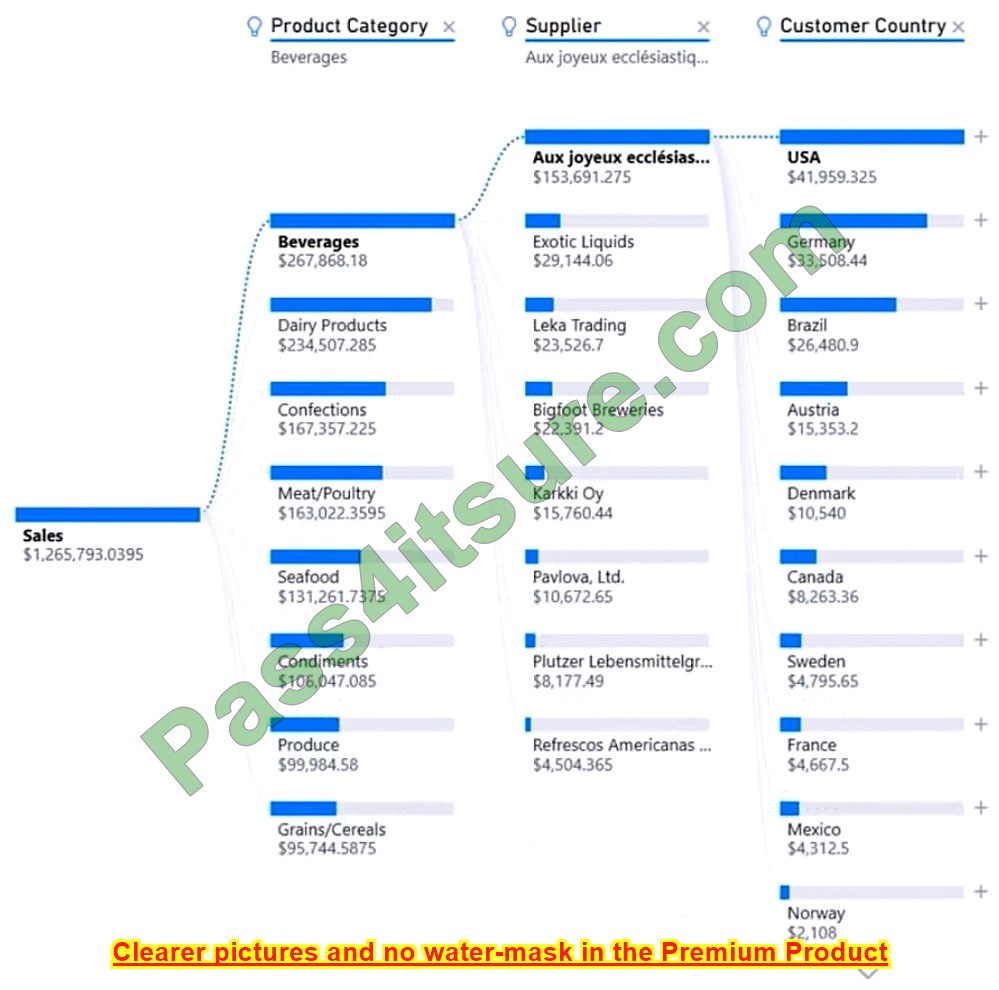
Which type of visual should you use?
A. QandA
B. decomposition tree
C. smart narrative
D. key influencers
Correct Answer: B
The decomposition tree visual in Power BI lets you visualize data across multiple dimensions. It automatically aggregates data and enables drilling down into your dimensions in any order. It is also artificial intelligence (AI) visualization, so you can ask it to find the next dimension to drill down into based on certain criteria.
This makes it a valuable tool for ad hoc exploration and conducting root cause analysis.
Example:
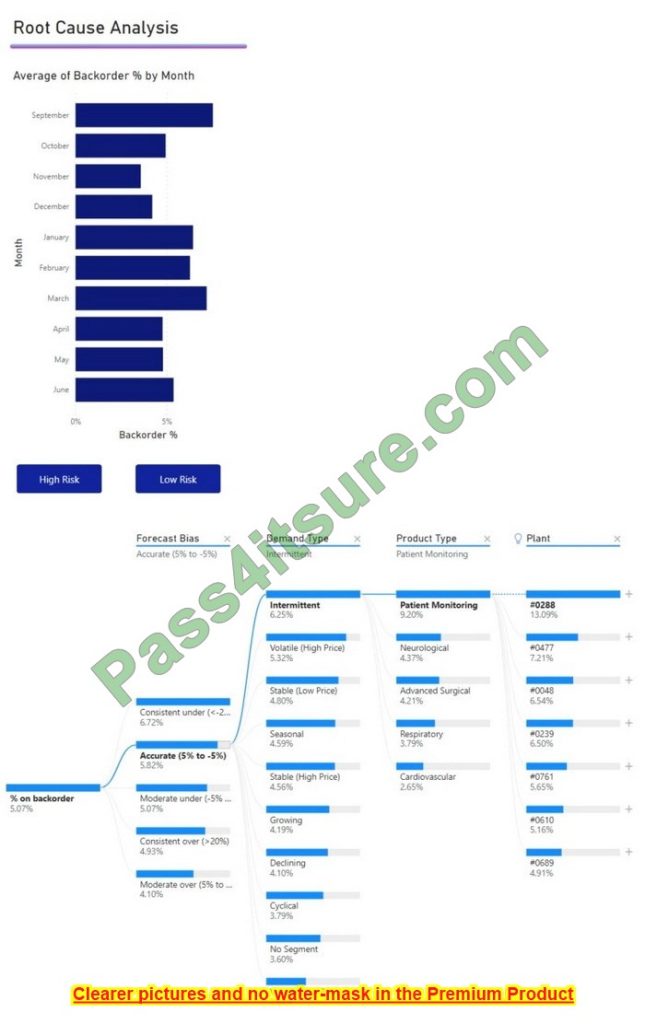
Question 3:
HOTSPOT
You need to create a visualization to meet the reporting requirements of the sales managers.
How should you create the visualization? To answer, select the appropriate options in the answer area.
NOTE: Each correct selection is worth one point.
Hot Area:
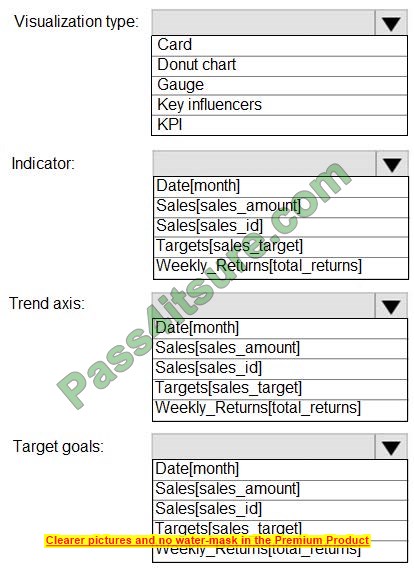
Correct Answer:
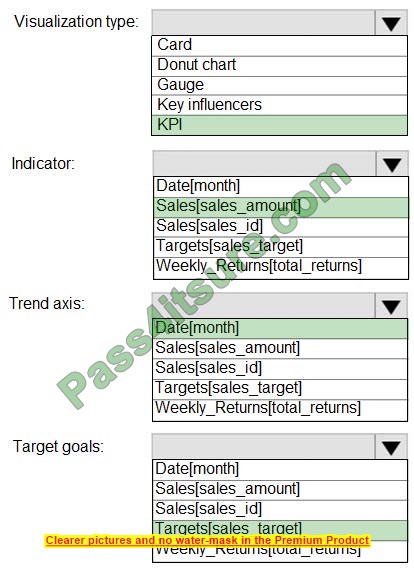
Scenario: The sales managers require a visual to analyze sales performance versus sales targets.
Box 1: KPI
A Key Performance Indicator (KPI) is a visual cue that communicates the amount of progress made toward a measurable goal.
Box 2: Sales[sales_amount]
Box 3: Date[month]
Time > FiscalMonth. This value will represent the trend.
Box 4: Targets[sales_target]
Reference:
https://docs.microsoft.com/en-us/power-bi/visuals/power-bi-visualization-kpi
Question 4:
You have the following table named Location.
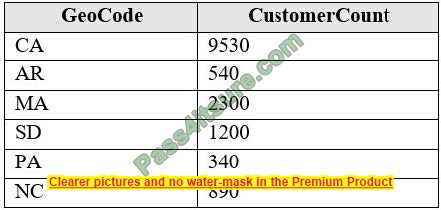
The GeoCode column represents the country where each customer is located. You create a map visualization as shown in the exhibit. (Click the Exhibit tab.)
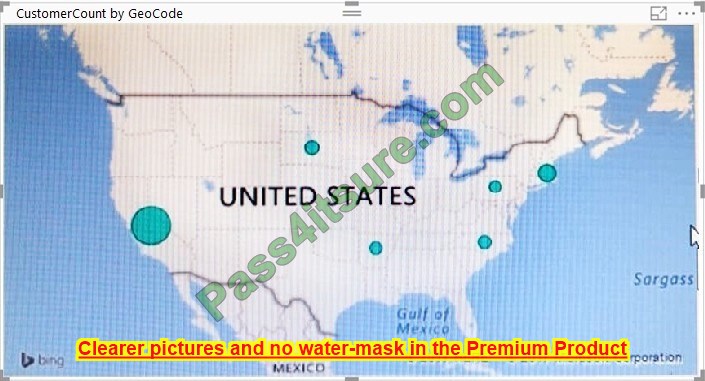
You need to ensure that the map displays the country locations. What should you do?
A. Replace the values in the GeoCode column with postal codes or zip codes.
B. Change the name of the GeoCode column to Country.
C. Change the name of the Location table to Country.
D. Change the Default Summarization of the GeoCode column.
E. Add a Geoportal column to the Location table.
F. Change the Data Type of the GeoCode column.
Correct Answer: B
References: https://docs.microsoft.com/en-us/power-bi/visuals/power-bi-map-tips-and-tricks
Question 5:
You build a report to analyze customer transactions from a database that contains the tables shown in the following table.
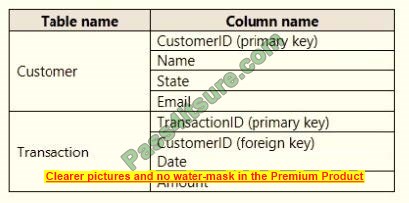
You import the tables.
Which relationship should you use to link the tables?
A. one-to-many from Customer to Transaction
B. one-to-one between Customer and Transaction
C. one-to-many from Transaction to Customer
D. many-to-many between Customer and Transaction
Correct Answer: A
Each customer can have many transactions.
For each transaction, there is exactly one customer.
Question 6:
You create a dataset sourced from dozens of flat files in Azure Blob storage. The dataset uses incremental refresh.
From powerbi.com, you deploy the dataset and several related reports to Microsoft Power BI Premium capacity.
You discover that the dataset refresh fails after the refresh runs out of resources.
What is a possible cause of the issue?
A. Query folding is not occurring.
B. You selected Only refresh complete periods.
C. The data type of the column used to partition the data changed.
D. A filter is missing on the report.
Correct Answer: A
The Power BI service partitions data based on a date range. This is what enables only certain partitions to be refreshed incrementally. To make this work, the partition filter conditions are pushed down to the source system by including them in the queries.
Using Power Query terminology, this is called “query folding”. It is not recommended that incremental refresh is used when the required query folding cannot take place.
Reference: https://powerbi.microsoft.com/en-us/blog/incremental-refresh-query-folding/
Question 7:
HOTSPOT
Your company has affiliates who help the company acquire customers.
You build a report for the affiliate managers at the company to assist them in understanding affiliate performance.
The managers request a visual showing the total sales value of the latest 50 transactions for each affiliate. You have a data model that contains the following tables.

You need to develop a measure to support the visual.
How should you complete the DAX expression? To answer, select the appropriate options in the answer area.
NOTE: Each correct selection is worth one point.
Hot Area:
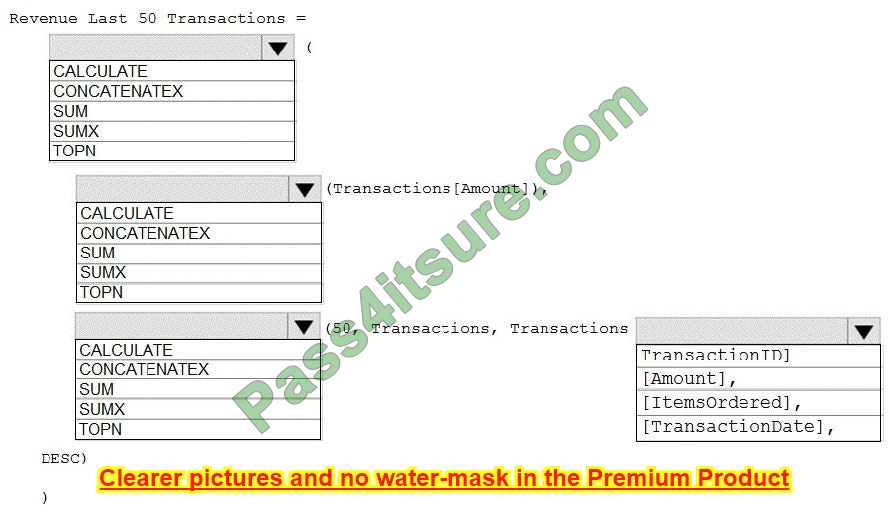
Correct Answer:
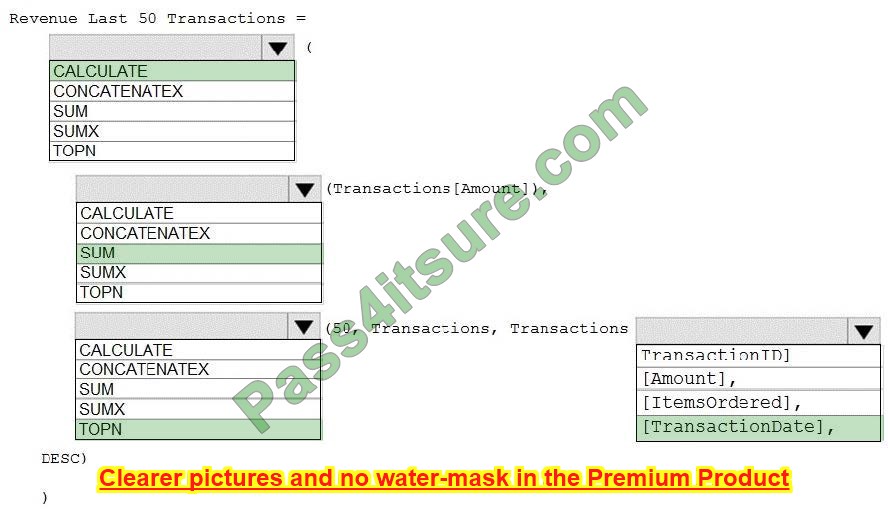
Box 1: CALCULATE
Start with CALCULATE and use a SUMX.
CALCULATE evaluates an expression in a modified filter context.
Box 2: SUM
Box 3: TOPN
TOPN returns the top N rows of the specified table.
Box 4: [TransactionDate]
TOPN Syntax: TOPN(,, , [[, , []]…])
The orderBy_expression: Any DAX expression where the result value is used to sort the table and it is evaluated for each row of the table.
Reference:
https://docs.microsoft.com/en-us/dax/topn-function-dax
Question 8:
HOTSPOT
You have a Power Bl report.
You have the following tables.

You have the following DAX measure.
Accounts :=
CALCULATE (
DISTINCTCOUNT (Balances[AccountID]),
LAST DATE (\’Date\'[Date])
For each of the following statements, select Yes if the statement is true. Otherwise, select No.
NOTE: Each correct selection is worth one point.
Hot Area:

Correct Answer:

Box 1: No
It will show the total number of accounts that were live on the last day of the year only.
Note:
DISTINCTCOUNT counts the number of distinct values in a column.
LAST DATE returns the last date in the current context for the specified column of dates.
Box 2: No
It will show the total number of accounts that were live on the last day of the month only.
Box 3: Yes
Reference:
https://docs.microsoft.com/en-us/dax/distinctcount-function-dax
https://docs.microsoft.com/en-us/dax/lastdate-function-dax
Question 9:
Note: This question is part of a series of questions that present the same scenario. For your convenience, the scenario is repeated in each question. Each question presents a different goal and answer choices, but the text of the scenario is exactly the same in each question in this series.
Start of repeated scenario
You have a Microsoft SQL Server database that has the tables shown in the Database Diagram exhibit. (Click the Exhibit.)
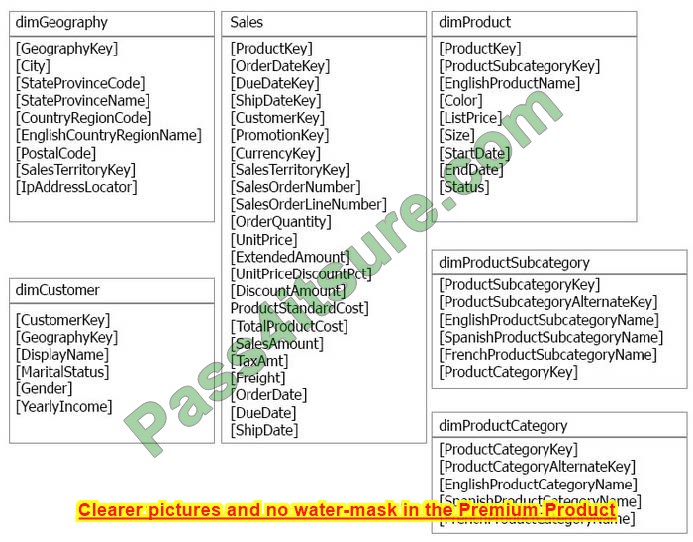
You plan to develop a Power BI model as shown in the Power BI Model exhibit. (Click the Exhibit).
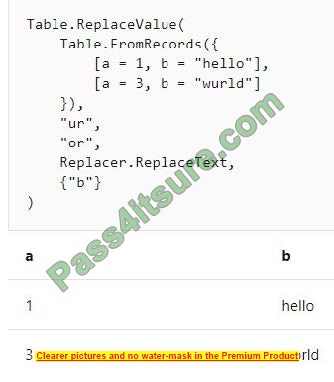
You plan to use Power BI to import data from 2013 to 2015. Product Subcategory [Subcategory] contains NULL values.
End of repeated scenario.
You implement the Power BI model.
You add another table named Territory to the model. A sample of the data is shown in the following table.
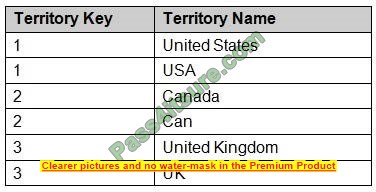
You need to create a relationship between the Territory table and the Sales table.
Which function should you use in the query for Territory before you create the relationship?
A. Table.RemoveMatchingRows
B. Table.Distinct
C. Table.InDistinct
D. Table.ReplaceMatchingRows
Correct Answer: B
References: https://msdn.microsoft.com/en-us/library/mt260775.aspx
Question 10:
You have a data model that contains many complex DAX expressions. The expressions contain frequent references to the RELATED and RELATED TABLE functions.
You need to recommend a solution to minimize the use of the RELATED and RELATED TABLE functions.
What should you recommend?
A. Merge tables by using Power Query.
B. Hide unused columns in the model.
C. Split the model into multiple models.
D. Transpose.
Correct Answer: A
Combining data means connecting to two or more data sources, shaping them as needed, then consolidating them into a user query. When you have one or more columns that you\’d like to add to another query, you merge the queries.
Note: The RELATEDTABLE function is a shortcut for the CALCULATETABLE function with no logical expression. CALCULATETABLE evaluates a table expression in a modified filter context and returns A table of values.
Reference: https://docs.microsoft.com/en-us/power-bi/connect-data/desktop-shape-and-combine-data
Question 11:
You have four sales regions. Each region has multiple sales managers.
You implement row-level security (RLS) in a data model. You assign the relevant distribution lists to each role.
You have sales reports that enable analysis by region. The sales managers can view the sales records of their region. The sales managers are prevented from viewing records from other regions.
A sales manager changes to a different region.
You need to ensure that the sales manager can see the correct sales data.
What should you do?
A. From Microsoft Power Bl Desktop, edit the Row-Level Security setting for the reports.
B. Change the Microsoft Power Bl license type of the sales manager.
C. Manage the permissions of the underlying dataset
D. Request that the sales manager be added to the correct Azure Active Directory group.
Correct Answer: D
Using AD Security Groups, you no longer need to maintain a long list of users.
All that you will need to do is to put in the AD Security group with the required permissions and Power BI will do the REST! This means a small and simple security file with the permissions and AD Security group.
Note: Configure role mappings Once published to Power BI, you must map members to dataset roles. Members can be user accounts or security groups. Whenever possible, we recommend you map security groups to dataset roles.
It involves managing security group memberships in Azure Active Directory. Possibly, it delegates the task to your network administrators.
Reference: https://www.fourmoo.com/2018/02/20/dynamic-row-level-security-is-easy-with-active-directory-security-groups/ https://docs.microsoft.com/en-us/power-bi/guidance/rls-guidance
Question 12:
Which two types of visualizations can be used in the balance sheet reports to meet the reporting goals? Each correct answer presents part of the solution.
NOTE: Each correct selection is worth one point.
A. a line chart that shows balances by quarter filtered to account categories that are long-term liabilities.
B. a clustered column chart that shows balances by date (x-axis) and account category (legend) without filters.
C. a clustered column chart that shows balances by quarter filtered to account categories that are long-term liabilities.
D. a pie chart that shows balances by account category without filters.
E. a ribbon chart that shows balances by quarter and accounts in the legend.
Correct Answer: AE
Question 13:
HOTSPOT
You have a report page that contains the visuals shown in the following exhibit.
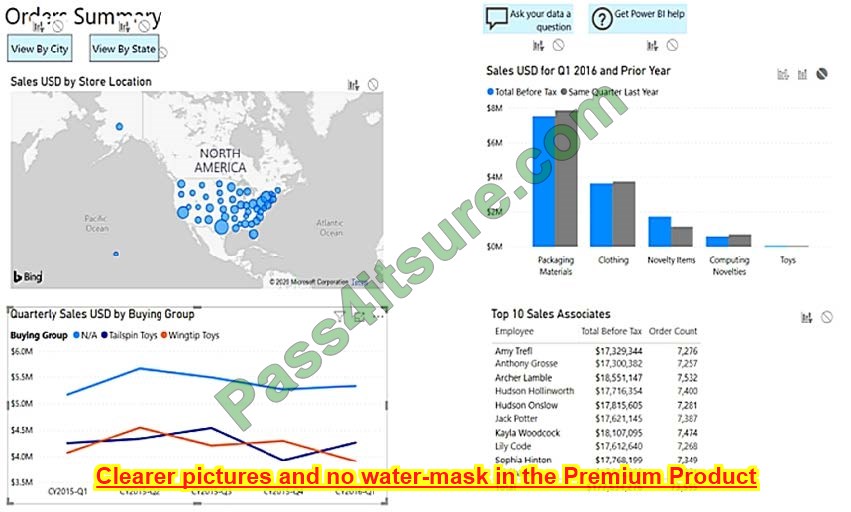
Use the drop-down menus to select the answer choice that completes each statement based on the information presented in the graphic.
NOTE: Each correct selection is worth one point.
Hot Area:
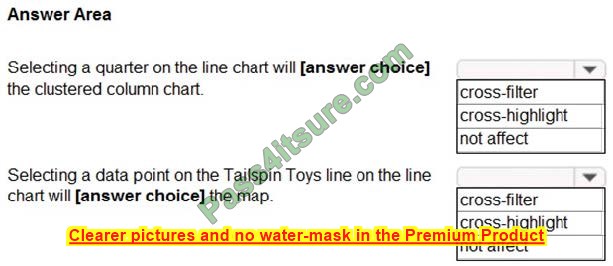
Correct Answer:
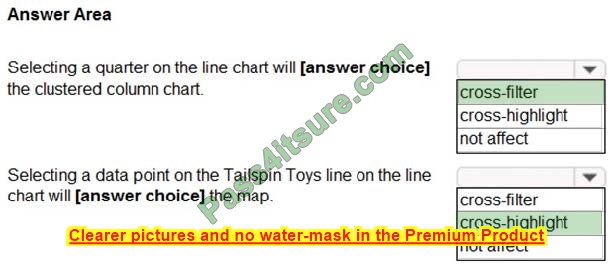
Box 1: cross-filter
By default, selecting a data point in one visual on a report page will cross-filter or cross-highlight the other visuals on the page.
Box 2: cross-highlight
Example:
By default, selecting a data point in one visual on a report page will cross-filter or cross-highlight the other visuals on the page.
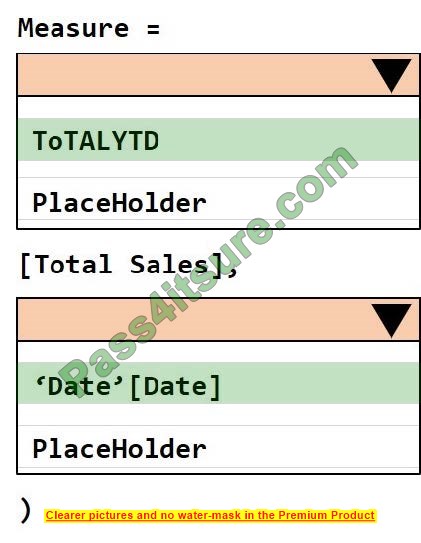
1. Let \’s seen what happens when we select Moderation.

2. Cross-filtering removes data that doesn’t apply. Selecting Moderation in the doughnut chart cross-filters the line chart. The line chart now only displays data points for the Moderation segment.
3. Cross-highlighting retains all the original data points but dims the portion that does not apply to your selection. Selecting Moderation in the doughnut chart cross-highlights the column chart. The column chart dims all the data that applies to the Convenience segment and highlights all the data that applies to the Moderation segment.
Question 14:
DRAG DROP
You have a query named Customer that imports CSV files from a data lake. The query contains 500 rows as shown in the exhibit. (Click the Exhibit tab.)
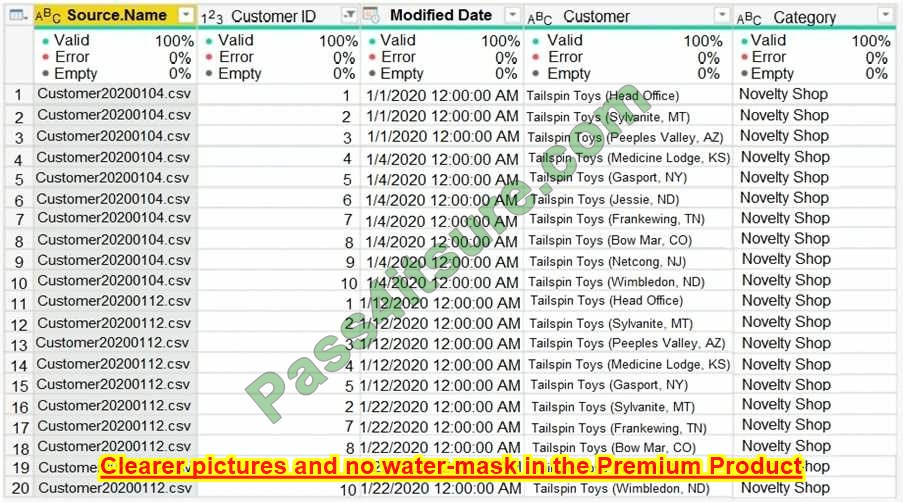
Each file contains deltas of any new or modified rows from each load to the data lake.
Multiple files can have the same customer ID.
You need to keep only the last modified row for each customer ID.
Which three actions should you perform in sequence? To answer, move the appropriate actions from the list of actions to the answer area and arrange them in the correct order.
Select and Place:
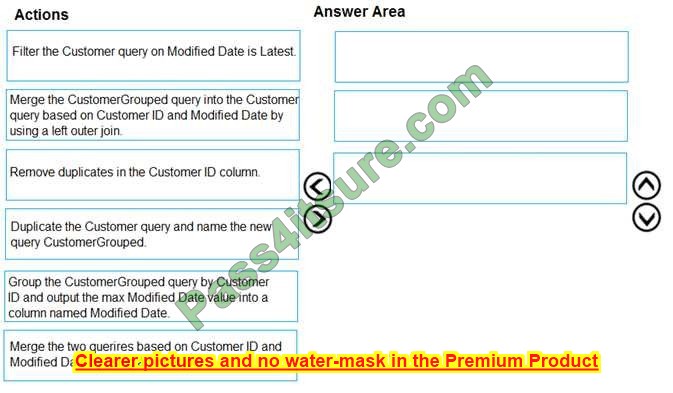
Correct Answer:
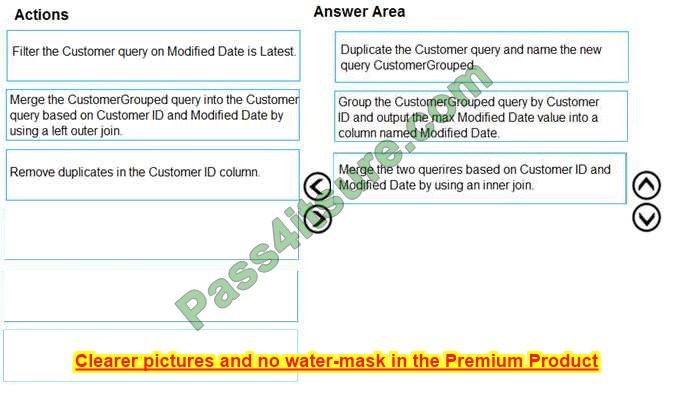
1) Duplicate Customer query
2) Group by CustId by Max ModifiedDate (only 2 columns to keep)
3) Merge two queries on CustId and ModifiedDate inner join (to receive other customer information related to the latest Date)
Question 15:
You have five sales regions. Each region is assigned a single salesperson.
You have an imported dataset that has a dynamic row-level security (RLS) role named Sales. The Sales role filters sales transaction data by the salesperson.
Salespeople must see only the data from their region.
You publish the dataset to powerbi.com, set RLS role membership, and distribute the dataset and related reports to the salespeople.
A salesperson reports that she believes she should see more data.
You need to verify what data the salesperson currently sees.
What should you do?
A. Use the Test as role option to view data as the salesperson\’s user account.
B. Use the Test as role option to view data as the Sales role.
C. Instruct the salesperson to open the report in Microsoft Power Bl Desktop.
D. Filter the data in the reports to match the intended logic in the filter on the sales transaction table.
Correct Answer: B
Validate the roles within Power BI Desktop
After you\’ve created your roles, test the results of the roles within Power BI Desktop. From the Modeling tab, select View as.

A picture containing the application
Description automatically generated View as roles window appears, where you see the roles you\’ve created.
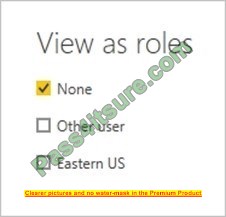
Select a role you created, and then select OK to apply for that role. The report renders the data relevant to that role.
You can also select Other user and supply a given user. The graphical user interface, application Select OK. The report renders based on what that user can see.
Reference: https://docs.microsoft.com/en-us/power-bi/admin/service-admin-rls
The above free practice questions are provided by Pass4itSure.
The PL-300 exam is a Microsoft Power Platform security, compliance, and management exam that is difficult and requires candidates to be proficient in a variety of Power Platform-related knowledge and technologies.
Practice tests are very important to prepare for the PL-300 exam
Specifically manifested in the following aspects, please see:
- Find out how difficult and what type of PL-300 exam you take
Practice tests can help candidates understand the difficulty and type of the test, understand the rules and answering skills of the exam, and better prepare for the exam.
- Familiarize yourself with the exam content and format
Practice tests can familiarize candidates with the content and format of the test, including the topics and skills of the test, the types, and a number of questions in the test, the time and score of the test, etc., which is conducive to candidates to be more confident and calm in the test.
- Improve the speed and accuracy of answering questions
Practice makes perfect, which helps candidates solve questions more efficiently in the exam.
- Close knowledge gaps
Practice tests can help candidates identify their own knowledge loopholes and weaknesses, and adjust their study plans and preparation strategies in a timely manner.
- Improve your confidence in preparing for the exam
This is also the most essential point of the exam, and self-confidence is very important for the Microsoft Power BI Data Analyst exam.
In conclusion, practice tests are very important to prepare for the PL-300 exam, and candidates need to improve their preparation efficiency and accuracy through practice tests to better cope with the challenges of the PL-300 exam.
Download the Pass4itSure PL-300 dumps https://www.pass4itsure.com/pl-300.html (All practice questions) now to get the full practice test and prepare for the exam.
I wish you all a happy exam.